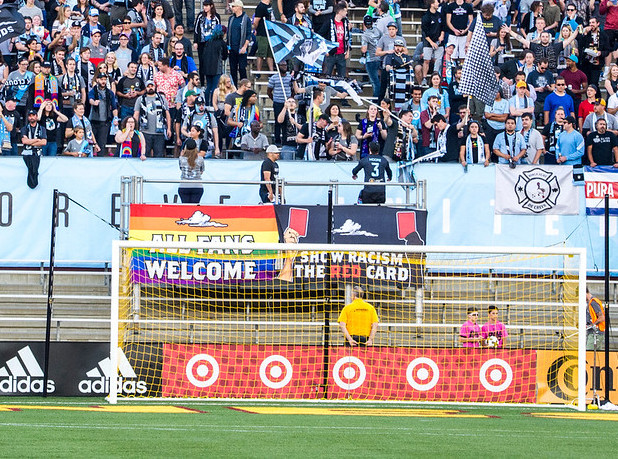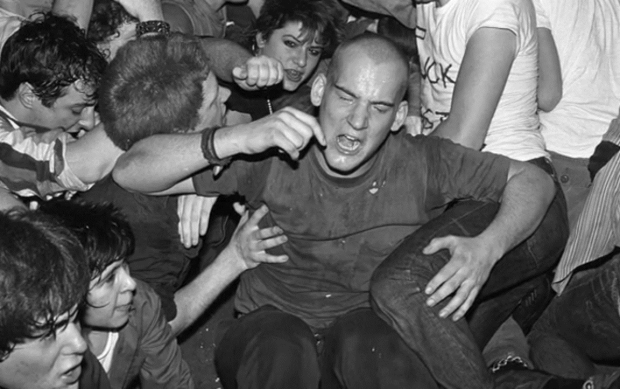“If the kids are united
Then we’ll never be divided”
-Sham 69
Nicholas Bisbee, co-founder of True North Elite, asked me a question on twitter about the similarities of the hardcore music scene and soccer supporters culture. Here’s the original question:
Didn’t know you were a hardcore guy! Lived out in Boston and started a band for a couple years before coming back to MN in ‘14.
What similarities do you see in supporter culture and hardcore scene?— Nicholas Bisbee (@niccobiz) May 22, 2018
This is something I’ve thought a lot about. I was involved with the Rochester, NY and Chicago hardcore scene in the late 90s and early 00s; and the similarities between the punk/hardcore/metal scenes (at least at that time) and the supporter culture today in U.S. and Canadian soccer seem very strong to me.
It’s not an accident that so many of the long time soccer supporters here in Minnesota have also been interested or involved in those scenes. Minnesota United’s former coach Carl Craig was in a punk band in his youth in Newcastle. St. Pauli, likely the most well known of the “punk” soccer clubs, is known for its left wing beliefs and punk rock support.
I’ll note, these are only based on my experiences in both scenes. Many people might have had different experiences, and I encourage you to sound off in the comments. I’ll be adding your comments directly into this piece, with attribution of course, to make sure other voices besides mine are heard.
Space for people that feel like outcasts

For many, many years, being a supporter of soccer seemed like you were a member of a secret club. Hardcore music was the same way. If you saw a person wearing a Minor Threat shirt, or a jacket with a Misfits or Black Flag patch, you felt an instant kinship with that person.
At college, the dozen or so of us who liked hardcore music gravitated toward each other. We even started hosting our own hardcore shows on campus to have a space for us.
The same thing happens for supporters of soccer. For years, the only way to watch soccer was on obscure streams or in bars. So supporters started gathering together, finding like-minded souls, and creating spaces where they could enjoy and celebrate their favorite sport together.
Speaking to long time Dark Clouds members, they would speak of 20 to 30 hearty souls who would stand together and heckle the opposition in the last days of the Minnesota Thunder.
Supporters groups tend to bring together people who don’t fit in with other sports fans.
Purity tests
Both supporters culture and punk/hardcore culture can have some form of purity tests. In hardcore, this was primarily about “selling out.” It’s never quite clear what exactly constitutes selling out, but it’s one of those things where “you know it when you see it.”
The same can be true in supporters culture, but usually it’s about what “good” or “proper” support looks like. Are you a real supporter if you support an MLS side? If you don’t support your local side? If you disagree with how the support looks, acts, or sounds like in your local supporters section? If you criticize your team or coach? What is a supporter “allowed” and “not allowed” to do?
There’s also the assumption that real punks or supporters don’t ever stop being a punk or supporter. A common joke during my time in the hardcore scene was that someone who got a straight edge tattoo would break the edge shortly after. Implied in that joke was that these people were never really straight edge. During particularly tough stretches for a club, the supporters are quick to say that they will support the team no matter what.
Supporters are expected to remain loyal to a team that likely didn’t exist for more than five or 10 years.
DIY

Supporters are creative and will create their own merchandise and spaces, the same way hardcore music has had to do over the years. In the 80s, a whole subculture of zines, venues, and distros sprung up to help propagate a style of music that was ignored in the mainstream.
In soccer, supporters create banners, tifo, scarves, t-shirts, hoodies, and countless other gear to support the community’s desire for self-expression.
Both scenes are filled with people who believe that they can create something, and so they do. Whether it’s a community, a scarf, or a record, both groups believe that there is an innate value and sense of control in creating something yourself.
Scene politics
Both cultures deal with scene politics. Sometimes this is related to things like “purity tests,” and sometimes it’s just related to the fact that both scenes tend to be small and the same people keep running into each other. Some people are bound to rub each other the wrong way.
When you have passionate people there are bound to be differences of opinions. When it’s just a matter of getting a couple of guys and girls together to put together a new band or create a new supporters group, there’s bound to be an ever shifting array of allegiances and squabbles.
Collective singing

My favorite memories from hardcore shows are making my way to the front and having the microphone shoved in my face and proudly singing the words to the song. The supporters section has the feel of a tamer mosh pit, with a couple hundred people singing along, loudly and off key.
It doesn’t hurt that a fair number of the common chants are based off of punk songs.
Majority white, majority male
Whiteness and maleness pervade both scenes. While supporters in Minnesota have done so much to make the supporters groups more inclusive, it is still majority white and majority male.
There are many women, people of color, and members of the LGBTQ community that are part of the soccer supporters community in Minnesota, as well as within the hardcore community. I do not note the maleness and whiteness to belittle their contributions or to imply that they are not part of the community.
The fact remains that both communities can seem, at times, unwelcoming simply because of the racial and gender makeup of the communities, or even because of the subconscious biases and micro-aggressions by people who are white or male in the community.
Strong progressive/social justice beliefs

While these communities might be majority white and male, they both have strong beliefs in progressive, even radical, policies and social justice. Both supporters and hardcore fans have a belief that, through their respective communities, changes for the better can be made.
It’s no surprise that the the supporters for Minnesota United fly a rainbow flag with the words “all fans welcome,” just as it’s not a surprise that many hardcore kids or punks identify as socialists and anarchists. In my hometown of Rochester, NY, the punk shows would be put on by the local chapter of Anti-Racist Action and Food Not Bombs, two progressive organizations working to end racism and hunger respectively.
Both of the major supporters groups for Minnesota United FC have charity arms. That is true with many of the supporters groups throughout the U.S. and Canada.
A mirror
These similarities are not unique to just the punk/hardcore scenes and supporters culture, but are interesting and help to hold up a mirror to each respective subculture. I think, sometimes, these exercises can help understand what it truly means to say that one is a punk or a soccer supporter.
Please comment below to share your perspectives on the similarities and differences.
FiftyFive.One is now on Patreon. Do you like the independent coverage of soccer news from Minnesota and beyond that FiftyFive.One offers? Please consider becoming a patron.

Leave a Reply